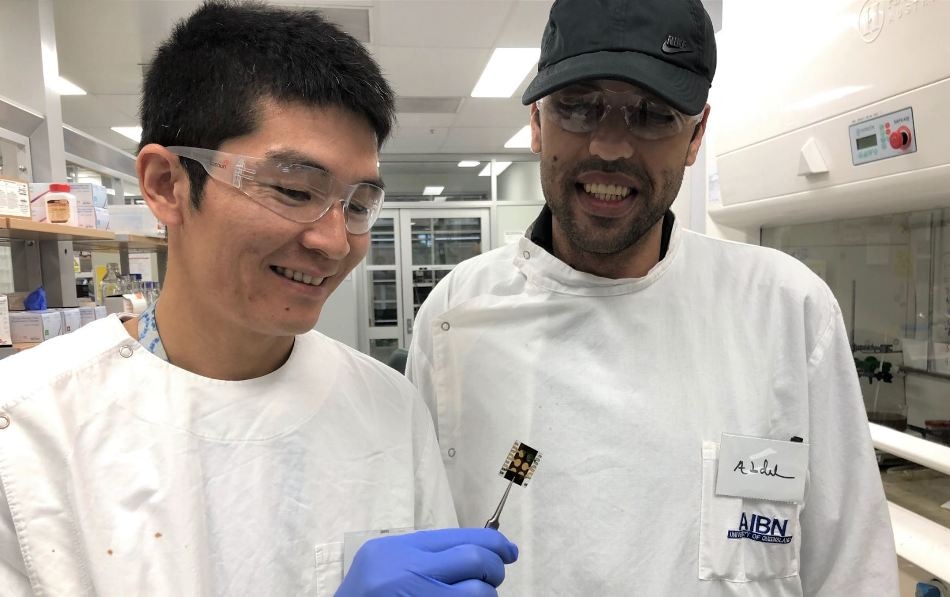Jun 24 2019
An innovative phosphorus-based nanomaterial called phosphorene is turning out to be an important ingredient for efficient and more sustainable state-of-the-art perovskite solar cells (PSCs).
 Solar cell researchers Dr Munkhbayar Batmunkh and Abdulaziz Bati, now at the Australian Institute of Bioengineering and Nanotechnology at the University of Queensland. (Image credit: Professor Joe Shapter)
Solar cell researchers Dr Munkhbayar Batmunkh and Abdulaziz Bati, now at the Australian Institute of Bioengineering and Nanotechnology at the University of Queensland. (Image credit: Professor Joe Shapter)
As one of the fastest developing new solar technologies, PSCs are capable of achieving efficiencies that are similar to more traditionally used silicon solar cells available in the market.
Now, for the first time, an international group of clean chemistry researchers, headed by Flinders University and Professor Joseph Shapter, has successfully developed extremely thin phosphorene nanosheets for use in low-temperature PSCs. The team achieved this breakthrough by utilizing the fast shear stress of the groundbreaking vortex fluidic device (VFD) developed by Flinders University.
Silicon is currently the standard for rooftop solar, and other solar panels, but they take a lot of energy to produce them. They are not as sustainable as these newer options. Phosphorene is an exciting material because it is a good conductor that will absorb visible light. In the past most non-metallic materials would have one property but not both.
Joseph Shapter, Adjunct Professor, The University of Queensland
Dr Christopher Gibson, Senior Research Fellow, College of Science and Engineering, Flinders University said, "We’ve found exciting new way to convert exfoliated black phosphorus into phosphorene which can help produce more efficient and also potentially cheaper solar cells. Our latest experiments have improved the potential of phosphorene in solar cells, showing an extra Star efficiency of 2%-3% in electricity production."
Research into developing high-quality 2D phosphorene in large amounts—together with other next-generation materials like graphene—is opening the door to more sustainable and efficient production through the use of near-infrared laser light pulses, the SA-made VFD, and also an industrial-scale microwave oven.
The work with phosphorene is exploring the addition of different atoms to the matrix which is showing very promising results in catalysis, particularly in the area of water splitting to produce hydrogen and oxygen.
Joseph Shapter, Adjunct Professor, Research Infrastructure, The University of Queensland
With the potential to synthetically create perovskite structures, commercial feasibility is at the threshold and can soon be realized once the perovskite cells are effectively scaled up. In the meantime, studies are ongoing worldwide to explore ways for improving and optimizing the performance of perovskite cells.
Colin Raston, Professor of Clean Technology; Dr Gibson; and Dr Kasturi Vimalanathan are among a team of researchers at Flinders Institute for Nanoscale Science and Technology who are seeking ways to enhance the efficiency of solar cells with new, improved processing systems and solar cell materials.
In addition, Professor Shapter is continuing the groundbreaking research on solar cells at the University of Queensland along with Abdulaziz Bati and Dr Munkhbayar Batmunkh, all co-authors of the latest paper titled, “Efficient Production of Phosphorene Nanosheets via Shear Stress Mediated Exfoliation for Low-Temperature Perovskite Solar Cells.”
M Batmunkh, K Vimalanathan, C Wu, ASR Bati, L Yu, SA Tawfik, MJ Ford, TJ Macdonald, CL Raston, S Priya, CT Gibson and JG Shapter (University of Queensland, Pennsylvania State, Virginia Tech, UTS, RMIT, UCL and Flinders University contributed to the paper, which has been reported in Small Methods (Wiley).
An Australian Research Council Discovery Program, Royal Society of Chemistry research grants, Microscopy Australia, Australian National Fabrication Facility, and the new Flinders Microscopy and Microanalysis Centre supported the latest study.